- NLI Research Institute >
- Carbon Dioxide Reduction in the Transport Sector Requires Market-Oriented Policies
Carbon Dioxide Reduction in the Transport Sector Requires Market-Oriented Policies
Tatsuya Kimura
Font size
- S
- M
- L
| Carbon Dioxide Reduction in the Transport Sector Requires Market-Oriented Policies
by Tatsuya Kimura Attention on global warming issues is mounting ahead of the Third Session of the Conference of the Parties to the United Nations Framework Convention on Climate Change (COP3) being held in Kyoto, Japan, in December 1997, which will establish reduction targets for global greenhouse gas emissions beyond 2000. Emission of carbon dioxide, the greenhouse gas most critical in preventing global warming, has increased significantly in Japan's transport sector. Of the many proposals being raised, we must concentrate our energy not only in areas that are highly susceptible to policy measures, such as modal shift and promotion of public transportation, but on market-oriented policies expected to have the biggest impact − effective and achievable controls to improve fuel consumption of private vehicles through fuel costs and taxes, and conversion of freight transport from private vehicles to value-added transport services. 1. Growing Interest in Global Warming (1) Harmful Effects of Global Warming In addition to causing sea levels to rise and flood lowlands, reducing food production by causing abnormal weather conditions, and causing water shortages by changing rainfall patterns, global warming also threatens to cause disease and increase death rates. Global warming is caused by rising concentrations of greenhouse gases in the atmosphere. Of the greenhouse gases emitted by people − including carbon dioxide methane, nitrous oxide, and freon − the most serious is the rising concentration of carbon dioxide from mass consumption of fossil fuels. The concentration of carbon dioxide has risen significantly since the beginning of the industrial revolution, reaching 28 percent as of 1994. The pace of increase has accelerated particularly since the 1950s, and is linked to substantial increases in atmospheric temperatures (Figure 1). Of all greenhouse gas emissions since the industrial revolution, the greatest impact on global warming throughout the world has come from carbon dioxide, with a 63.7 percent direct contribution. In 1993 alone, the impact of carbon dioxide in Japan was an astonishing 94.4 percent.
|
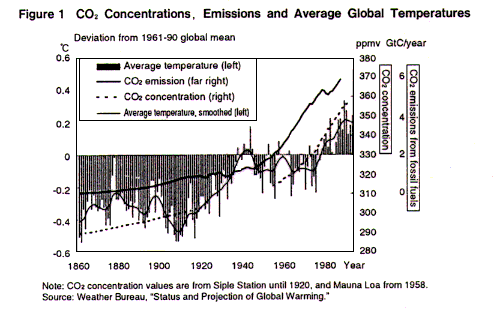
| (2) International Cooperation Begins in the 1980s
Serious organized research efforts into global warming began in the 1980s. In 1988, the first Intergovernmental Panel on Climate Change (IPCC) was held. At a global summit in 1992, 155 nations signed the Framework Convention on Climate Change aiming to stabilize the concentration of greenhouse gases. Under this agreement, the industrialized nations, former Soviet Union, and former countries in Eastern Europe committed to policies and actions to reduce greenhouse gas emissions by 2000 to 1990 levels. Following two conferences of member nations, the third session is being held this December in Kyoto, where a protocol will be adopted containing targets for beyond 2000 (Table 1).
|
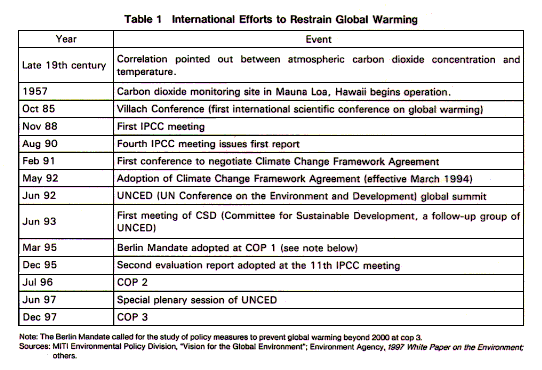
|
2. Steady Rise in Japan's Carbon Dioxide Emissions Since Fiscal 1987 (1) Transport and Public Welfare Sectors Produce Most Emissions Japan's carbon dioxide emissions declined from the first oil shock in fiscal 1974 until fiscal 1986, and leveled off before increasing thereafter. In fiscal 1994, 91.7 percent of carbon dioxide emissions were related to energy consumption: 89.5 percent from the industrial sector, 23.7 percent from the tertiary industry and household sector, 19.2 percent from the transport sector, and 7.7 percent from the energy conversion sector.1 The downtrend and leveling off until fiscal 1986 were largely due to reductions in the industrial sector, the largest producer of carbon dioxide emissions. Although industrial emissions rose during the bubble era as energy efficiency measures peaked out, the increase was halted again from fiscal 1991, and by fiscal 1995 emissions had declined to fiscal 1990 levels.2 However, increases have been steady and noticeable in the next largest emission-producing tertiary and transport sectors since the late 1960s. Since the first oil shock (fiscal 1974-94), emissions have increased at an average annual rate of 1.4 percent in the tertiary sector and 2.4 percent in the transport sector, compared to a 0.5 percent decrease in the industrial sector (Figure 2). Thus below we concentrate on ways to reduce emissions in the transport sector.
|
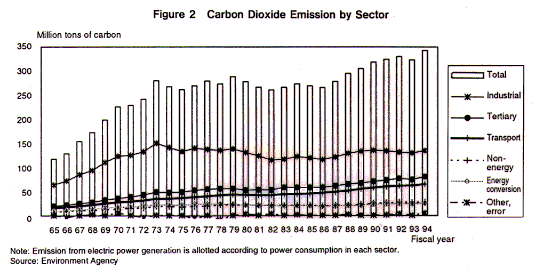
| (2) Status of Carbon Dioxide Emission in the Transport Sector
A major factor in the rise in carbon dioxide emissions in the transport sector was the increase in transport volume accompanying economic growth. Between fiscal 1965 and 1994, freight volume (ton-kilometers) grew 2.9 times, while passenger volume (passenger-kilometers) rose by 3.0 times. Another important factor was motorization, which increased the proportion of energy-inefficient cars (passenger cars in passenger transportation) in total transport volume, and decreased the proportion of more efficient railway and coastal shipping transport. The energy consumption unit cost (energy required for one unit of transportation), freight transport by automobiles amounted to 9.4 and 9.0 times, respectively, that of railways and coastal shipping. For passenger transport, the unit energy cost of passenger cars was 6.0 times that of railways. The proportion of freight transported by automobiles has doubled from 26.0 percent in fiscal 1965 to 51.3 percent in fiscal 1994, while the proportion of passenger transport accounted for by passenger cars has grown fivefold, from10.6 percent to 51.2 percent during the same period. As a result, 85.3 percent of carbon dioxide emissions in the transport sector (fiscal 1994) is accounted for by automobile transport of passengers and freight (Figure 3).
|
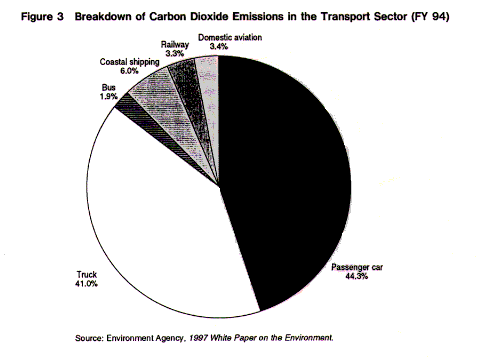
|
3. Carbon Dioxide Emission Reduction Measures for the Transport Sector (1) Classification of Carbon Dioxide Reduction Measures As the breakdown of Carbon Dioxide emissions in Figure 2 shows, policies taken thus far have been unsuccessful not only in reducing emissions, but in preventing increases. As Table 2 shows seven different approaches have been proposed to toughen emission standards: (1) direct emission controls (2) economic measures such as taxes and subsidies (3) technological measures by transporters such as improving fuel efficiency and reducing weight (4) modal shift (5) promotion of public transportation (6) efficient driving and transport (7) formation of urban structures that produce fewer carbon dioxide emissions.
|
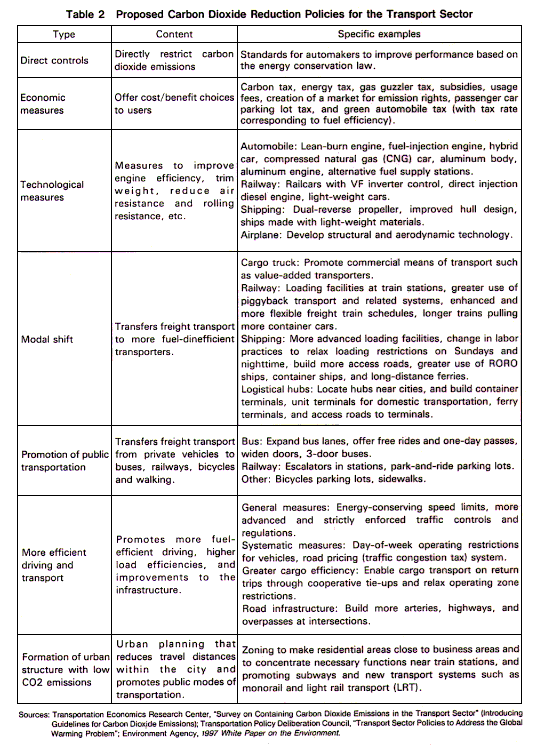
| (2) Effectiveness of Measures
In studying how best to toughen carbon dioxide emission standards, the government has calculated the cost and effectiveness of these approaches. 1. Carbon Tax, Energy Tax The Environmental Agency's Research Committee on Environmental Taxes, Penalties and Other Economic Means has estimated the impact of four proposals on economic controls combining a carbon tax, energy tax, and subsidy.3Of the four proposals, the most restrictive is estimated to produce a 1.7 percent increase (from 1990 levels) by 2010, compared to an increase of 7.5 percent without the taxation (Table 3).
|
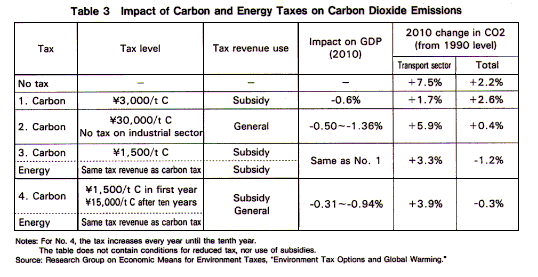
| 2. Modal Shift and Improvement of Load Efficiency
MITI has estimated the impact on emissions from measures to improve the efficiency of cargo transport. In the estimates, interregional transport would employ a modal shift and use larger vehicles, while intra-regional transport would convert from private to commercial vehicles and introduce low-emission vehicles to the extent possible. The most effective measure for reducing emissions was found to be conversion from private to commercial vehicles (32.0 percent reduction), which improves transport efficiency by greatly reducing the number of empty vehicles. Next most effective is the introduction of low-emission vehicles (4.6 percent reduction); modal shift would reduce emissions by only 1.3 percent (Table 4).
|
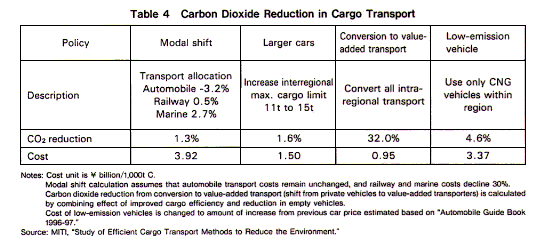
|
4. Importance of Carbon Dioxide Emission Reduction and Control Measures (1) Broad Scope of Planned Measures One indication of the direction of policies for the transport sector is the Ministry of Transportation's "Program of Transportation Policies for Carbon Dioxide Reduction" released in association with its fiscal 1998 budget request. As shown in Table 5, the content of the program is quite broad. However, the program does not project the extent of reduction in Carbon Dioxide emissions, and quantitative evaluations of the proposed measures are conducted separately. Since the carbon dioxide target for 2000 and beyond is to be determined at the Kyoto Conference in December, it is quite likely that action besides the program will also be taken.
|
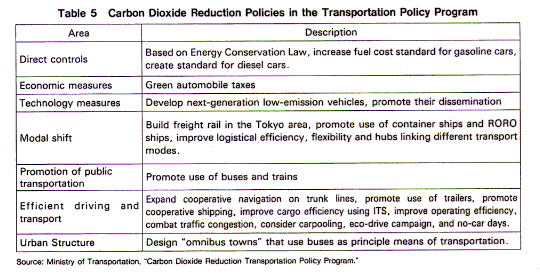
| (2) Need for Market-Oriented Measures
Japan's proposal for the Kyoto Conference had not been drafted as of the end of August. However, according to the second IPCC evaluation report, regardless of the specific level, stabilization of carbon dioxide concentrations requires that emissions be reduced by at least half of present levels. The EU proposal aggressively calls for a 15 percent reduction from 1990 levels by 2010. Thus the transport sector will need to reduce carbon dioxide emissions considerably to prevent global warming. Achieving this target will require a broad range of reduction measures. However, most important will be the following measures. 1. Passenger Transport: More Fuel Economy and Less Emissions Private automobiles account for approximately 85 percent of carbon dioxide emissions in passenger transport (and almost 90 percent of all automobiles). In addition, since private vehicles have a significant advantage over public modes of transportation in providing a private space and door-to-door transportation, public transportation can offer few incentives to boost ridership significantly. The thrust of policies for passenger transport should thus focus on providing tax and other incentives to improve engine efficiency and fuel consumption primarily of private vehicles, and to promote low-emission vehicles through tax and other incentives. In other words, policies need to offer market incentives and choices without reducing the convenience of private transportation to users. 2. Cargo Transport: Value-Added Logistical Businesses In cargo transport, while private vehicles account for approximately 45 percent of emissions, much of this proportion can be converted to commercial vehicles. Thus a reduction in emissions is achievable by improving transport efficiency. In fact, according to government estimates, the most effective and low-cost measure of the proposed measures is to shift from private vehicles to commercial trucks. Admittedly, the estimates adopt the extreme assumption that all transport done by private vehicles will be converted to commercial vehicles. Yet it is true that aside from certain cases which require judgment of the choice of cargo such as delivery of fresh foods, a considerable portion can be converted. A key factor in the conversion is that truck transport operators promote a value-added approach known as third party logistics (3PL), which has already been implemented to improve profitability. In this scheme, truck operators undertake all aspects of the logistics business, engaging in physical distribution processing and data processing, and proposing a physical distribution system that reduces overall costs. It will encourage the conversion by systematically and efficiently serving not only large consignors trying to reduce logistics costs, but also smaller businesses and proprietorships who have relied on private means of transport to ship small volumes. While competition in the 3PL business is expected to intensify and drive down profit margins of truck operators, the business also offers new opportunities to enhance profitability by expanding the scope of business. In addition, it will allow companies to reduce large physical distribution costs, a problem plaguing many companies. The conversion from private to commercial means of transport will not only improve efficiency, but is also easier to implement than policy-induced measures such as modal shift, which have shown little progress. Presently, carbon dioxide emissions of the transport sector comprise approximately one-fifth of the total. If circumstances remain unchanged under the inevitable trend of motorization, this proportion will grow further. To counter this trend, policies will need to rely not only on restrictive measures but on consumer choices guided by market incentives.
Notes
|
Tatsuya Kimura
Research field
レポート紹介
-
研究領域
-
経済
-
金融・為替
-
資産運用・資産形成
-
年金
-
社会保障制度
-
保険
-
不動産
-
経営・ビジネス
-
暮らし
-
ジェロントロジー(高齢社会総合研究)
-
医療・介護・健康・ヘルスケア
-
政策提言
-
-
注目テーマ・キーワード
-
統計・指標・重要イベント
-
媒体
- アクセスランキング

















